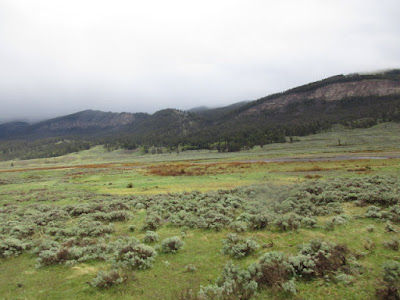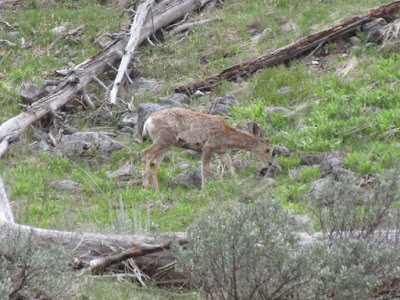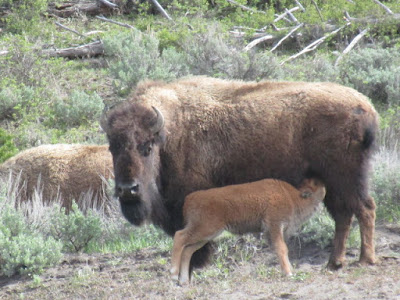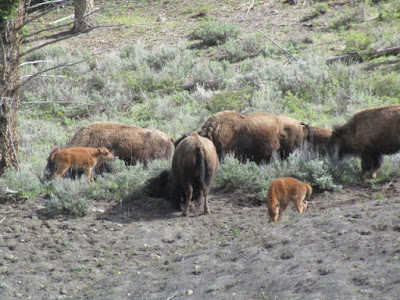"Oh give me a home, where the buffalo roam..."
...and I'll know I'm in Yellowstone!
Yellowstone! One word conjures up all sorts of images, but the word itself is recognized the world over. Yellowstone is the United States first National Park, created by an act of Congress in 1872 under the Presidency of Ulysses S. Grant. In the early days, people traveled to Yellowstone by train. In 1903, a train depot was built at the entrance bringing visitors directly to Yellowstone. An arch was built to accentuate the importance of this great park and named for then President, Theodore Roosevelt, who also placed the last stone.
Yellowstone is more than just a park. It is an environment made of a variety of ecosystems and climates.
It is mountains,
and alpine lakes,
canyons,
 |
| Yellowstone River Canyon; the park got its name from the yellow rock in the canyon |
 |
| Firehole River Canyon |
meadows and grasslands,
waterfalls,
 |
| Lower Falls on the Yellowstone River |
 |
| Gibbon Falls |
and hot springs.
 |
| Beryl Spring |
Six rivers, numerous streams and the Continental Divide run through it.
 |
| Gardiner River |
 |
| Gibbon River |
And so does the 45th Parallel!
In one day you can experience spring showers,
summer sun,
and winter snow, sleet and hail.
 |
| Dunraven Pass |
It is buffalo,
and elk,
antelope or deer,
and the harder to find bear, coyote and, wolf.
We were also graced with the presence of this beautiful Trumpeter Swan gliding down Firehole River!
Yellowstone is an amazing place.
It was the next big place on our list of "Most Amazing National Parks" that we were trying to visit.
We came here first about 25 years ago, when our kids were in their teens. My memories were vague. It was time to come back and remember what we had forgotten.
Yellowstone is not a park to try and see in one day. You can hit a few highlights, but there is so much you will miss. The inner road around the park is 153 miles long! This does not include the distance from any of the entrances which can range from 5 miles to 29 miles. We camped in West Yellowstone, a town just outside the park. The west entrance is the most popular entrance. The entrance to the main circle was 14 miles through some of the prettiest buffalo territory in the park.
Signs warned people (sometimes fruitlessly) to stay back from wildlife. Here, the river separates the animals from the crowds, but buffalo cross the river all the time!
Male buffalo tend to keep to themselves or in small groups.
 |
| Cowbirds line up in a row on the back of this male buffalo. Indians used to call them Buffalo Birds. The birds eat ticks off of the animals so they are very beneficial. |
Of course the babies were the most fun to watch. We experienced everything from watching them romp and play to nursing from mom.
We will never see the numbers of buffalo that once roamed this great land, but they are no longer on the verge of extinction. They are making a comeback.
Most people plan to visit for a day or two. We spent five days there and saw most of it. Most of it? Yep. Like I said, Yellowstone is big! As much fun as it is to watch the animals, the hot springs are one of the park's biggest draws.
Yellowstone's most famous feature is Old Faithful. Old Faithful isn't the biggest geyser, but it is the only large one that can easily be timed (withing 20 minutes or so.)
 |
| Old Faithful in geyser mode! |
While most of the attractions are pull-outs or moderate sized parking lots with boardwalks to view the hot springs, Old Faithful is THE attraction, with its own visitor center, snack bar, lodge, etc. The anticipated time of the next 'show' is posted, but can be anywhere from 10 minutes before to 20 minutes after its appointed time. It is a "Guess-timation". We waited about 20 minutes from the posted time, but we were not alone. There are rows of benches almost a third of the way around, and a boardwalk that encircles the geyser so no one will miss the show!
Geysers and hot springs are all over.
Watching the steam rise from the earth as you drive makes you realize you are driving around on what was once a huge volcano and Mother Earth is still venting.
 |
| Orange Spring |
There are mud pots
And paint pots
geysers,
and hot springs.
I love the yellow flowers that surround this spring. They became a sign for me to look closer whenever I saw them. There was usually a small spring nearby.
I mentioned that we didn't see all of Yellowstone. Tower Falls is one place I didn't actually see. It was a lovely day when we left the campground. By the time we got to the Tower Falls on the far side of the park there was a half inch of hail on the ground and it was cold, windy and raining. I decided to forgo the hike up to the viewpoint for the falls. Other places were either too busy, or we were trying to get back to the RV to unwind. There comes a time when you say, "I've seen enough. Time for a break."
Yellowstone is a busy park. Although we went before Memorial Day, we had to wait on the road for a space in the parking lot for Midway Geyser Basin. We were told by June 12 it will be almost impossible to get into that basin. There are only three hot springs there, but they are popular ones and the boardwalk is lengthy. The boardwalks are necessary to keep people off the fragile surface around the springs. There are fissures underground and new springs crop up all the time. There are constant warning signs for people to stay ON the boardwalks.
 |
| Excelsior Geyser is now dormant as a geyser but it spills 4050 gallons of water per minute, which flows into the Firehole River |
For me, I was happy to marvel at the way the sky was reflected in the mineral water runoff that surrounded the spring. It really was beautiful.
 |
| The Turquoise Pool was the epitome of beautiful. |
 |
| Full grown trees would dwarf this buffalo. These trees are only around 25 years old. |
All of it was a result of the 1988 fires. I became really interested in what I was seeing. We came here first in 1990, 2 years after the fires. There was so much burned forest, it was sad. But we also saw the very beginnings of recovery. Blue wildflowers were dotting the hillsides along with little green shoots among the fallen trees. This time there were sign posts telling us more about what we were seeing.
The forest is mostly Lodgepole Pines. Lodgepole Pines grow to 70'-80' and are highly adaptable to all sorts of environments. They grow rather slowly at a rate of 1'-2' a year and hold on to their pine cones until they are quite old, or something causes the cones to open. Fire is one thing that awakens those pine cones. In 1988, the forest was weakened from drought and disease. As the fire burned the old trees, the pine cones burst open, spreading their seeds. 28 years later, I was seeing the return of the forest. Nature takes care of its own!
We also noticed many trees had bark stripped from them about 4-5' from the ground.
Our first assumption was that it was from the elk rubbing the velvet from their antlers. We noticed it was more prevalent in certain areas. In one wooded picnic area, every tree was marked. There had to be more to the story, so we asked a park ranger. We weren't far from the mark. It was actually buffalo that rub their horns against the tree. They also rub their backs against the tree to help get their thick winter coat off!
This rest area reminded us that wildlife come through here. First, there was the markings on the tree, and then we saw the cow patties left in the parking lot!
Before I leave Yellowstone, I want to share just a little of the things that would catch us off guard and make us say "HUH?"... or maybe just "WOW". The truth is, the park is so big, with such a varied story, it is impossible to really show it. (But I gave it a shot!)
 |
| Does this single little tree growing out of a rock look as defiant to you, as it does to me? |
 |
| Speed limit? Make up your own! |
 |
| A simple reminder the weather can change at any moment...and does! |
 |
| Afternoon Siesta in Mammoth Hot Springs |
They own the town, too, when they want to.
There are two things that got my attention at this falls. 1) The power and force of that water that just kept coming. Wow! And 2), do you see that tiny tree growing in that falls. HUH? How does it do that? Why hasn't it been swept away?































































No comments:
Post a Comment